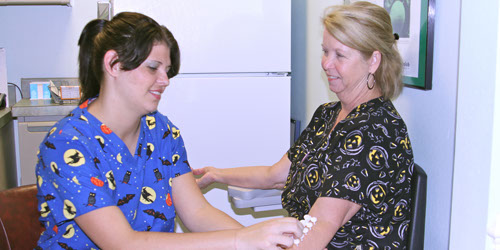

SINUS
ALLERGIES / SINUSITIS
ABOUT SINUS ALLERGIES / Sinusitis
Indoor and outdoor allergens include: pollen from ragweed, pet dander, dust, and mold.
Sinus Allergies
Most sinus allergies occur mostly in spring, late summer and early fall seasons. During this time, the air is dry and moisture free and it's the right time for airborne particles like pollen and ragweed to flow in the air. Therefore, this time is very critical for diseases concerned with allergies.
Symptoms of Sinus Allergies
Some of the symptoms of these allergies are very common but should not be ignored. Any one or more of these symptoms are enough to make a person weak and fatigued all the time:
- Runny nose
- Excessive sneezing (it can be 8 to 10 times in a row)
- Itching nose (feel like scratching)
- Sore throat
- Bad breath
- Watery eyes
- Postnasal drip
- Loss of taste and smell
- Excess coughing, especially in the night
- A cold that lingers
Treating Sinus Allergies
We treat allergies in our sinus clinic in our office:
- Needle-less testing for allergies conducted in our office
- Allergy injections provided in our office
- Sinus allergy injections for immediate relief
Acute Sinusitis
Acute Sinusitis comes on suddenly, often right after an upper respiratory infection, like a cold. It is often painful.
How do you treat Acute Sinusitis?
Acute Sinusitis most often can be managed with prescribed medication and self-care. Medication helps combat the underlying cold or allergy so the sinuses can recover. Self-care can keep sinuses moist and make you feel more comfortable.
Self Care for Allergies
Self care includes:
- Drinking more fluids – a glass every hour or two – makes your mucus thinner allowing it to drain from your sinuses more easily. A humidifier helps in much the same way. Fluids can offset the drying effects of certain drugs.
- Use saltwater rinse to keep your nose and sinuses moist. Mix a teaspoon of salt in 8 ounces of fresh, warm water. Use a blub syringe to gently squirt the water into your nose a few times a day. Ready made saline nasal solutions are available.
- Apply hot and cold packs – applying heat the area surrounding your sinuses may make you feel more comfortable. Use a hot water bottle or hand towel dipped in hot water. Some people find ice packs are effective at relieving pain.
Chronic Sinusitis treatment
While medications work in many cases, sometimes it is not completely effective in managing chronic sinusitis. The goal of surgical treatment for chronic sinusitis is to enlarge the inflamed or obstructed sinus passageways. Post-surgery check-ups are required to inspect the sinus cavities to monitor for inflammation and scarring and treat accordingly with surgery and/or oral steroids.
Dr. Humphreys may suggest surgery– which could include the new Propel Implant surgery.
Propel Implant Surgery
This new FDA-approved treatment for sinusitis, Propel, is a dissolvable, steroid-releasing implant that provides patients controlled delivery of the steroid directly into the sinus tissue to maintain the opening created during surgery. The goal of surgical treatment for chronic sinusitis is to enlarge the inflamed or obstructed sinus passageways. Post-surgery check-ups are required to inspect the sinus cavities to monitor for inflammation and scarring and treat accordingly with surgery and/or oral steroids.
How Propel works
PROPEL is clinically proven to maintain sinus patency after surgery by propping open the sinuses in a spring-like fashion and by providing for safe, effective and localized delivery of steroid directly to the sinus lining. The self-expanding implant conforms to the highly variable sinus anatomy and effectively delivers anti-inflammatory medication where it’s needed most as the implant dissolves.
Surgery
Dr. Humphreys will discuss all of the options with you concerning your sinus issues. When sinusitis does not respond to medications, surgery may be needed. It will be a decision you and Dr. Humphreys discuss.
Balloon Sinuplasty
Balloon Sinuplasty opens blocked sinuses with the use of a balloon system in a minimally invasive treatment for individuals suffering sinusitis. The procedure uses a small, soft, flexible device introduced endoscopically through the nostrils. A balloon is gently inflated to open blocked sinus passages. No bone or tissue is removed during this procedure, and the need for uncomfortable nasal packing is eliminated.
Balloon Sinuplasty procedures
The procedure uses a small, soft, flexible device introduced endoscopically through the nostrils. A balloon is gently inflated to open blocked sinus passages. No bone or tissue is removed during this procedure, and the need for uncomfortable nasal packing is eliminated!
An alternative to sinus surgery, Dr. Humphreys uses an FDA-approved endoscopic balloon sinuplasty technique similar to balloon angioplasty for the heart. The procedure can be done in the office.
Recovery time is faster than in conventional sinus surgery. Pain is significantly reduced. Most return to normal activities in 24 hours.
This procedure is the first breakthrough technology in the care and cure of sinusitis in 20 years, and Dr. Humphreys has been providing this revolutionary treatment since 2008.